Answered step by step
Verified Expert Solution
Question
1 Approved Answer
The following information relates to Handy Hardware Incorporated, and All Tools Corporation for their 2 0 1 7 and 2 0 1 6 fiscal years.
The following information relates to Handy Hardware Incorporated, and All Tools Corporation for their and fiscal years.
HANDY HARDWARE INCORPORATED
Selected Financial Information
amounts in millions, except per share amounts
January January
Total current assets $ $
Merchandise inventory
Property and equipment, net of depreciation
Total assets
Total current liabilities
Total longterm liabilities
Total liabilities
Total shareholders equity
Revenue
Cost of goods sold
Gross profit
Operating income
Earnings from continuing operations before income tax expense
Income tax expense
Net earnings
Basic earnings per share $ $
ALL TOOLS CORPORATION
Selected Financial Information
amounts in millions except per share data
January January
Total current assets $ $
Merchandise inventory
Property and equipment, net of depreciation
Total assets
Total current liabilities
Total longterm liabilities
Total liabilities
Total stockholders equity
Revenues
Cost of goods sold
Gross profit
Operating income
Earnings from continuing operations before income taxes
Income tax expense
Net earnings
Basic earnings per share $ $
Required
a Compute the following ratios for the companies fiscal years years ending in January :
Current ratio.
Average days to sell inventory. Use average inventory.
Debttoassets ratio.
Return on investment. Use average assets and use Earnings from continuing operations before income taxes rather than net earnings.
Gross margin percentage.
Asset turnover. Use average assets.
Return on sales. Use Earnings from continuing operations before income taxes rather than net earnings.
Plant assets to longterm debt ratio.
b Which company appears to be more profitable? Identify which ratios from Requirement a you used to reach your conclusion.
c Which company appears to have the higher level of financial risk? Identify which ratios from Requirement a you used to reach your conclusion.
d Which company appears to be charging higher prices for its goods? Identify which ratios from Requirement a you used to reach your conclusion.
e Which company appears to be the more efficient at using its assets? Identify which ratios from Requirement a you used to reach your conclusion.
Step by Step Solution
There are 3 Steps involved in it
Step: 1

Get Instant Access to Expert-Tailored Solutions
See step-by-step solutions with expert insights and AI powered tools for academic success
Step: 2

Step: 3

Ace Your Homework with AI
Get the answers you need in no time with our AI-driven, step-by-step assistance
Get Started


